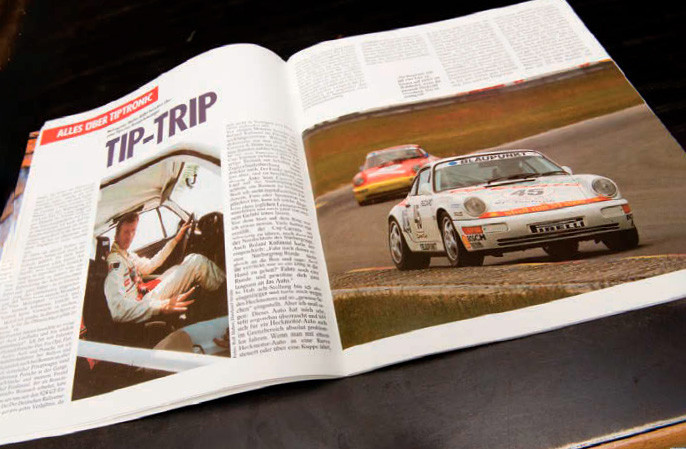Driving a road-legal 1990 Porsche 911 Carrera Cup 964
Can a 964 Carrera Cup racer be tamed for road use? To find out, we strap in for what proves to be a drive on the wild side of Porsche life...
Words Steve Bennett
Photography Dan Pullen
964 CARRERA CUPROAD-LEGAL RACER TRIED AND TESTED
GREAT WHITE
Driving a road-legal 964 Carrera Cup.
Road racer! There has to be an exclamation mark after such a statement, and while Porsche didn’t invent the concept, it will forever be associated with epic closed road events, such as the Mille Miglia and Targa Florio, not to mention homologated RS and GT sports cars, built in road specification to satisfy the rules and regulations of international motorsport. Without Porsche’s desire to compete, there would be no Carrera RS 2.7, which is a sobering thought.
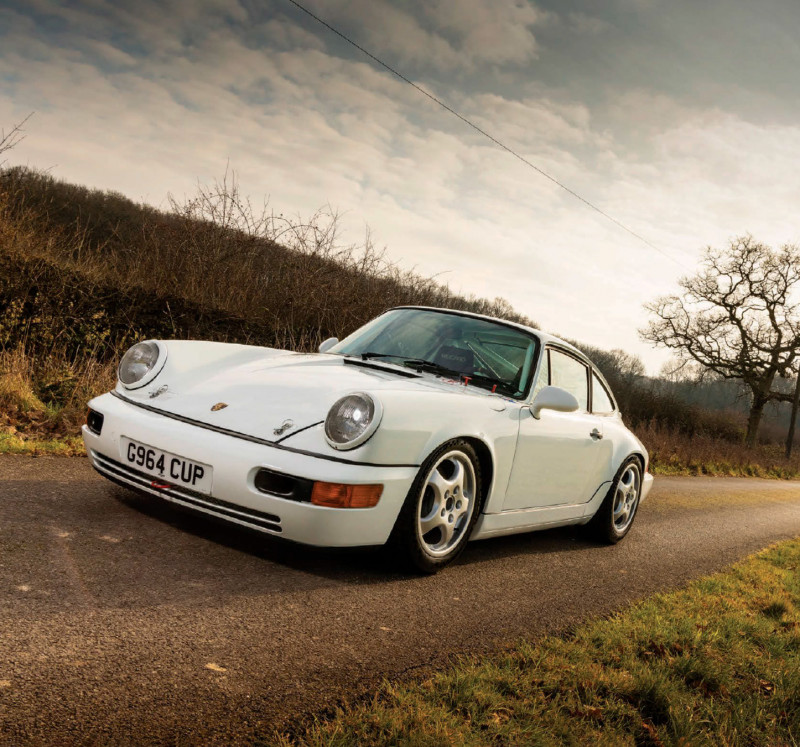
Porsche has always had an active factory and customer motorsport programme. Indeed, from the 550 Spyder to the current generation of 911 Carrera Cup and RSRs, there has barely been a single Porsche race car unavailable off-the-shelf and ready to race. Every now and again, these very machines get re-purposed for the road. In the extreme, there is the madness of taking a 917 (think Count Rossi) and converting it for street use. Slightly less bonkers is the 962 road car concept, famously pitched by Vern Schuppan, Koenig, DP Motorsport and others. More likely — and more sanely — for the track-to-road treatment, however, is the 911.
THE FIVE-SPEED GETRAG G50 GEARBOX HAD CLOSER RATIOS AND STEEL SYNCHROS, PLUS A LIGHTWEIGHT FLYWHEEL
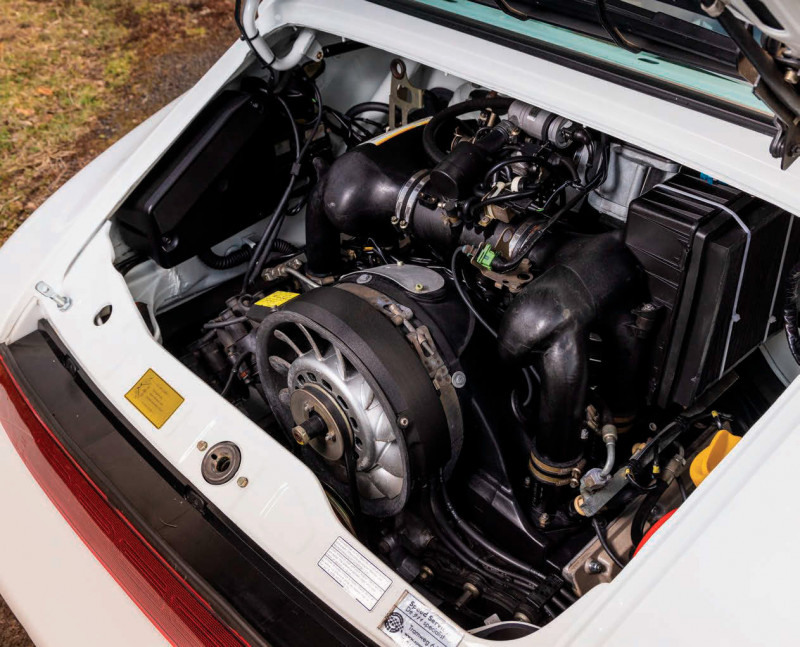
There’s no shortage of candidates, but since the advent of Carrera Cup in 1990, the number of former 911 racers has swelled to the point reverse engineering one of these cars for the road has become more than fair game. This is why I’m gingerly pointing one of Porsche’s first Carrera Cup machines not out of the pitlane, but on to Surrey’s B2128, with as much subtlety as I can muster. Having said this, much of the noise from this stripped-out racer is on the inside, which is likely why there is an intercom system, complete with headphones for driver and passenger. I’m also mindful of the fact this now road-legal racer was once driven by very handy wheelmen. No pressure, then.
THE STEERING MIGHT BE UNASSISTED, BUT A DOLLOP OF APEX-HUNTING NEGATIVE CAMBER TAKES THE STING OUT OF IT
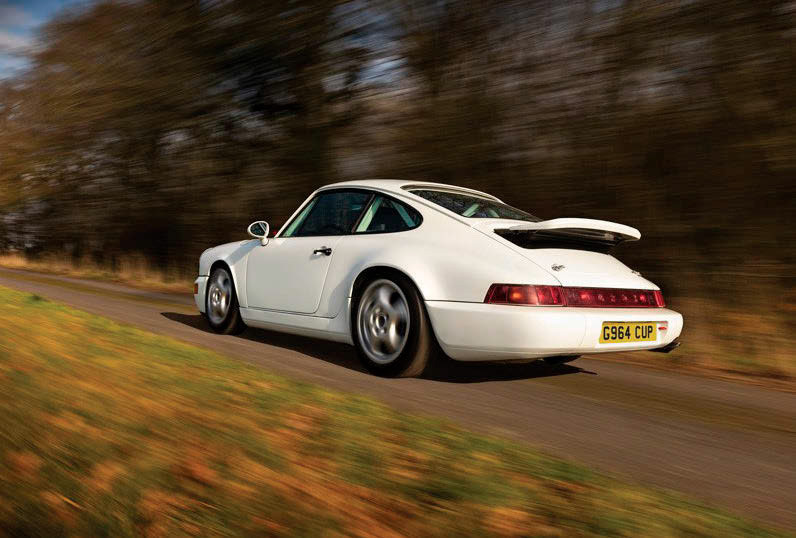
Let’s not race too far ahead. There’s obviously quite a backstory here, not least the origins of Carrera Cup and the history of this particular Porsche.
OF THE FIFTY CUPS ASSEMBLED, PORSCHE RETAINED TEN, RUNNING THREE AS GUEST CARS FOR THE LIKES OF MIKA HAKKINEN
Born out of the 944 Turbo Cup, which ran from 1986 to 1989/1990, Carrera Cup was timed to take advantage of (and cash in on) the launch of the 964-generation 911. Porsche, headed by Ulrich Bez, reasoned the 911 was the “backbone” of the company and “therefore needed to be supported.” What better way than going racing? Some thirty-three years on, this question has been more than answered — Carrera Cup competitions are staged in thirteen different countries across the world, supporting some of the biggest race programmes out there. In the UK, for example, Carrera Cup Great Britain serves as support act to rounds of the British Touring Car Championship, while winners of their respective domestic Carrera Cup competitions can go on to race in Porsche Mobil 1 Supercup on the same bill as Formula One. No surprises the 964 Cup is based on the 964 Carrera 2. Developed for the track by Jürgen Barth and factory race engineers, Helmut Flegl and Roland Kussmaul, the Cup variant was relatively simple in its specification, which makes it quite suitable for a street conversion. Typically, bodyshells painted white were taken from the production line, minus underseal and sound deadening.

Aluminium bonnet replaces steel up-front, while thinner glass was used throughout. Extra safety and strength came from a welded-in Matter roll cage. Door trims were simplified, manual windows replaced electric (and contributed to the lightweight wiring loom), a lightweight race battery was used, as was a simple heater/ blower. A lone Recaro race seat faced a stock instrument panel on an otherwise cut-down dashboard. All of this contributed to dry weight of 1,120kg.
TOWER OF STRENGTH
Wimpy power steering was replaced by a manual rack. Bilstein race dampers and stiffer Eibach springs were used in place of the standard MacPherson struts, along with a purge on rubber bushes for ball joints and solid mounted suspension, Adjustable top mounts allowed configurable camber. Roll bars were two and a half times stiffer, as well as being five-way adjustable at the front and three-way at the rear, giving teams and drivers plenty of scope for the perfect set-up (or to get in a muddle!). The 964 Turbo hadn’t yet arrived at this point in the 964’s development curve, but the force-fed model’s bigger Brembo four-pot calipers and discs were already waiting in the wings. They were swiftly applied to the 964 Cup car. Perhaps unusually for a racer, the hydraulic brake master cylinder was retained, as was ABS, not only to save drivers effort, but also in a nod to promoting then relatively new anti-lock braking technology.
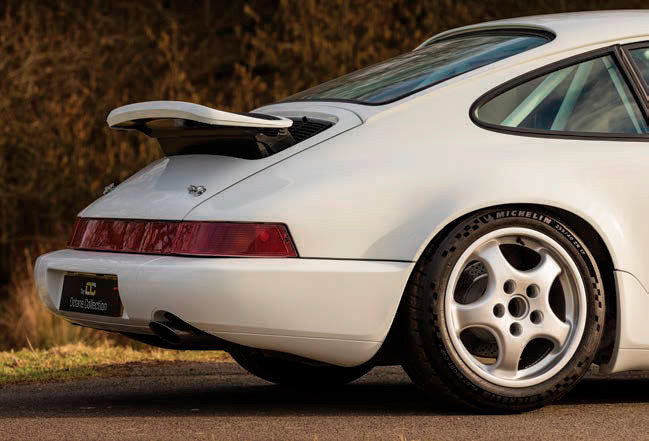
964 Cup racers rolled on what would simply become known as ‘Cup’ wheels, that is to say seventeen-inch five-spoke Speedlines (eight inches wide at the front, 9.5 at the rear) wrapped with Pirelli slicks. The 3.6-litre flat-six, meanwhile, was largely stock, although Kussmaul later confirmed only the very best engines were selected and further blueprinted. A lightweight air filter housing was developed for these air-cooled powerplants, which were, of course, sans power steering pump. Carefully ECU-tuned for 98 RON fuel, 964 Cup power figures ranged from 268bhp to 272bhp, with peak power achieved at 6,700rpm. Not bad, given the standard Carrera engine developed 250bhp. And, despite being track focused, the Cup engines retained a three-way catalytic converter, Germany being ahead of the PR curve on emissions and the green agenda.
The five-speed Getrag G50 gearbox had closer ratios and steel synchros, plus a lightweight flywheel and strengthened Sachs clutch. A limited-slip differential with a forty percent locking factor was added to the mix. Note ‘synchros’. Porsche has long equipped its racers with a synchro (rather than straight-cut) gearbox, maintaining it makes for a more reliable and driverfriendly transmission, even if it comes at the expense of horsepower, thanks to the drag of a helical gear set.
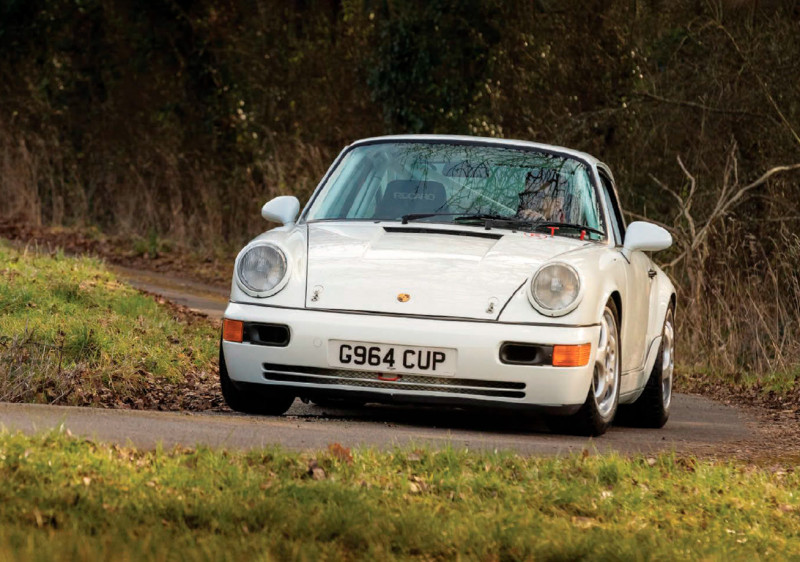
Sticking with the gearbox theme, Porsche was keen to see whether it could use the 964 Cup racer to promote its new Tiptronic gearbox, no doubt recalling how Sportomatic transmission had been celebrated for smashing the punishing eighty-four- hour Marathon de la Route on the Nürburgring when fitted to a two-litre 911 R. Drivers, Vic Elford, Hans Herrmann and Jochen Neerspasch, were all enthusiastic about Sportomatic, which made life very easy indeed, taking the clutch out of the equation. The Tiptronic experiment would prove interesting in back-to-back tests. With two lightweight (but not Cupspec) 964 development cars at Vallelunga, and with Kussmaul at the wheel of both, the four-speed Tiptronic equipped 964 was actually 0.1% faster than the manual. At the Nürburgring, the latter lapped just 0.15 seconds quicker. In truth, the fast Vallelunga circuit flattered the Tiptronic’s four ratios. At the Green Hell, running on its own, the same was true. Perhaps it’s time to view Tiptronic in a rather different light?
A Tiptronic-equipped 964 Cup racer was built and campaigned, just the once, by two-time World Rally Championship victor and long-time Porsche test driver, Walter Röhrl, at the Nürburgring in 1990. He qualified sixth, but in the cut and thrust of a four-lap race, the Tiptronic and its four speeds didn’t have the firepower or flexibility for racing combat against the manual Cup car’s closer four ratios, combined with longer fifth. As Röhrl said on record, “Tiptronic is good, it is easy, I cannot over-rev the engine. It’s the future of gearbox technology.” Off the record, he revealed the system’s shortcomings. “It is very hard for me, because I only have four gears,” he commented. “Actually, I have just three usable gears because the first one is too short. I can manage to compensate on a circuit like the Nordschleife, but was seven seconds slower than the best Carrera Cup time. During practice, I was alone, meaning I could carry speed into corners, but in the race, the other cars slowed me down. After the corner, I had no momentum.” Still, from the man who once described counter-intuitive, steering wheel-mounted PDK button shifters as “shit”, his appraisal was far from damning.
NIFTY FIFTY
Tiptronic gearbox diversion aside, in the spirit of ‘build and they will buy’, Porsche did just that, rolling out fifty 964 Cup cars at $73,650 a pop between late 1990 and early 1991. Racing commenced in Zolder on 31st March 1991. An international field of drivers participated. Of the fifty Cups assembled, Porsche retained ten, running three as guest cars for the likes of Mika Hakkinen, Kevin Schwantz and the aforementioned Röhrl. Key engine parts and ECUs were sealed, and the top-three race finishers were scrutineered after each event to make there was no funny business going on.
Other countries came on board, year by year, starting with France in 1992, which brings us to the 964 you see here, currently for sale at Horsham-based Octane Classics, a company which has kindly offered us a drive. Tough life and all that.
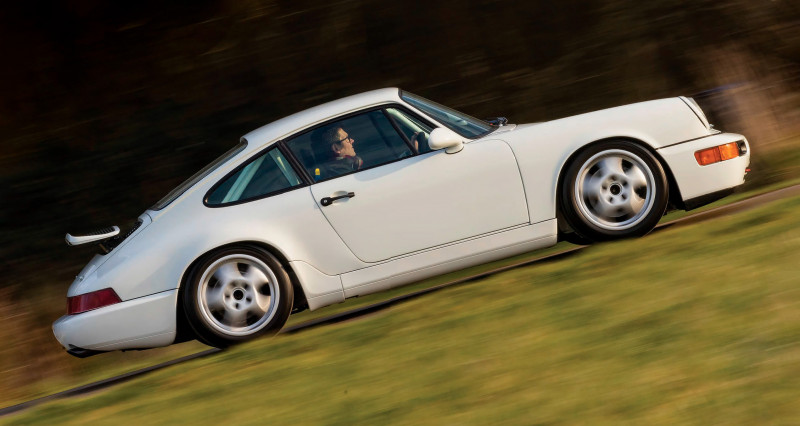
As is often the way with race cars, it has taken a fair amount of sleuthing to ascertain the exact timeline and build of this Carrera Cup veteran, but research reveals it was one of the first fifty cars built. Number forty-eight, in fact. In Maxcom Computer livery, the car was used to promote France’s then forthcoming 1992 Carrera Cup, but it never actually raced. Instead, the car was retired for a year or so, returning to the track for the final two rounds of the Belgian Belcar endurance series in 1994, with star drivers, Dirk de Weert, Ludo Plessers and Christian Lahaye, at the controls.
The trail then goes cold — a legal dispute over ownership saw the 964 placed in long-term storage from the end of 1994 to 2007, from which it emerged with a little over two thousand miles on the clock, tallying with its promotional/poster car work and its brief, two-race competition history.
Well-known Netherlands-based Porsche specialist, Speedservice, undertook to recommission the car and perform a precautionary engine rebuild. Turning it into a road-legal 911 wasn’t a big job, given its near street-spec anyway, requiring little more than the relevant paperwork and a set of Michelin Pilot Cup tyres. The car then made its way to the UK, where a patchwork of liveries was removed in favour of Weissachprescribed Grand Prix White.
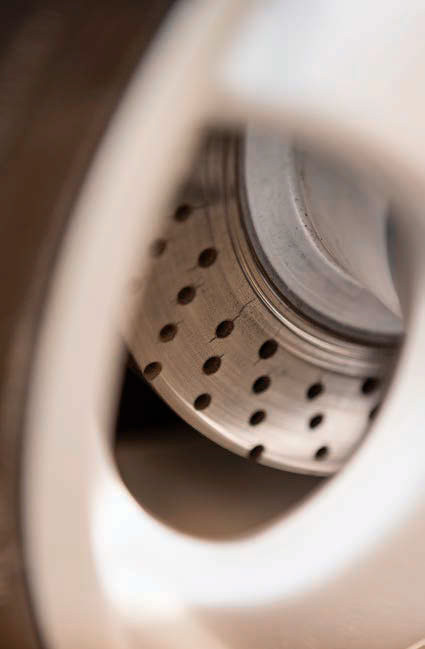
Sparingly used by its current owner, this rare 964 has most recently been in the professional hands of Precision Porsche for fresh plugs (that’s all twelve), valve cover gaskets, fuel filter and brake fluid change. This is, then, a fighting fit 964 Cup ready to road race, which, of course, is where Classic Porsche enters the story.
Back to the B2128. Strapped firmly into the Recaro race seat and gripping the dished OMP steering wheel, there is the small matter of £199,995 to consider. That’s what Octane Classics are retailing this 964 Carrera Cup for. Too much? In the great scheme of air-cooled Porsches, probably not. This particular Cup car’s racing provenance might not be massive, but its sparing use means only 2,379 miles have been covered. Besides, original specification counts for a lot. And the price is line with current 964 Carrera RS values, a model which the 964 Cup both pre-dates and most certainly influenced. There are no surprises here, really. This car does rather drive like a hardcore 964 Carrera RS. Or even more hardcore, given the RS’s raw and unforgiving reputation. Leaving that aside for a moment, the actual physical act of driving this Porsche is in no way hardcore. The clutch might be tougher, but it’s perfectly manageable, and the gearbox is light and synchro-aided. The steering might be unassisted, but a dollop of apex-hunting negative camber takes the sting out of it.
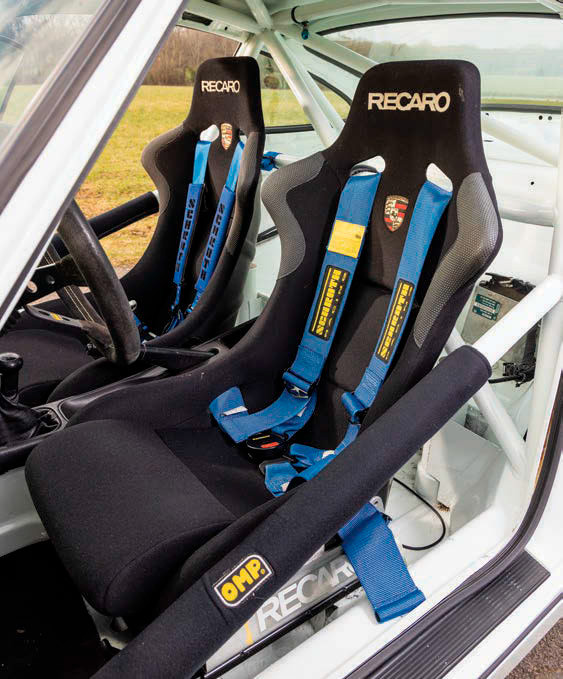
And, of course, this is a super-narrow 911, which always helps, particularly with a leftie. It’s the Porsche way. There’s no point in making a car hard work to drive, after all.
Don’t be misled, though. Even standing still, this 964’s stance seethes with pent-up aggression. The controls might not be hard work, but the sheer sensory overload of noise, lightweight performance and unfiltered feel certainly is, in a very visceral and very rapid sort of way. The balanced and electronically tweaked engine responds with instantaneous vigour, and while 270 or so horsepower might not be a great deal in the here and now, it’s more than sufficient in a 911 this light.
TIPPING THE SCALES
Back to the RS comparison and it’s 1,120kg versus 1,230kg. Because the 964 is small and narrow, you can use it all in a way you can’t in a modern GT Porsche. It’s a wild ride in every sense. Dynamically, it’s pure 911, but turned up to eleven. You can sense the engine hanging out in the breeze, but the balance stays just the right side of edgy. Just. On this basis, it would be a complete fib to say the suspension lives and breathes with a typical UK B-road, whether it be the B2128 or otherwise. It doesn’t, fighting the lumps and bumps every inch of the way. If you really wanted to road race this 911, then perhaps opt for something a bit more bespoke and forgiving than the race-spec Bilsteins and springs. At least experiment with spring rates. We would imagine teams would have had a choice of springs in period. If you were planning on track day adventure, then okay, perhaps leave things as they are. Whatever, UK roads demand something more akin to a tarmac rally car.
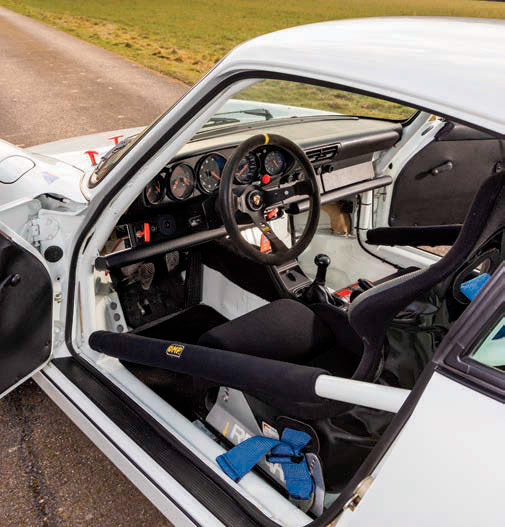
As an occasional light snack (raw meat, perhaps?!) or as an early morning blast machine to a cars and coffee meet, this bright white 964 would certainly blow the cobwebs away, but is it fair to try and tame a legitimate racer? It’s rather like trying domesticate a tiger, surely? This road-race 964 Carrera Cup is certainly an acquired taste, but if you like your thrills served up raw, it’s potentially the drive of your life.
IT WOULD BE A COMPLETE FIB TO SAY THE SUSPENSION LIVES AND BREATHES WITH A TYPICAL UK B-ROAD
Above Switch spring rates and the Cup will be far more compliant on the road
Above Want to see this very 964 sitting in your garage? Thanks to its availability through The Octane Collection, you can turn dream into reality, providing you’ve got £200k to spend.
Above It’s doesn’t possess the most practical of interiors, but if you intend to use this car for trackday use, being able to drive to your favourite circuit and home again may prove a huge boon.
Below Frunk and engine lid pins aside, there’s little to visually separate the 964 Carrera Cup from an RS
Above Roland Kussmaul is on record saying only the very best flat-sixes were selected and blueprinted for use in 964 Carrera Cup cars
Above and below Despite its motorsport underpinnings, the 964 Carrera Cup is so closely related to its roadgoing siblings, converting for use on the road is a relatively straightforward affair.
Above This Grand Prix White 964 Cup was originally dressed in Maxcom livery and helped to promote the launch of Carrera Cup France
Below Walter Röhrl tests a Tiptronic-equipped 964 Cup
